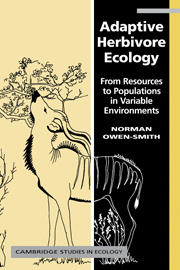Description
Adaptive Herbivore Ecology
From Resources to Populations in Variable Environments
Cambridge Studies in Ecology Series
Author: Owen-Smith R. Norman
A unique monograph describing plant–herbivore interactions in the context of large African herbivorous mammals.
Language: English
Subject for Adaptive Herbivore Ecology:
Approximative price 54.78 €
In Print (Delivery period: 14 days).
Add to cart
Adaptive Herbivore Ecology
Publication date: 06-2010
Support: Print on demand
Publication date: 06-2010
Support: Print on demand
Approximative price 156.60 €
Subject to availability at the publisher.
Add to cart
Adaptive Herbivore Ecology : From Resources to Populations in Variable Environments
Publication date: 06-2002
392 p. · 16.2x23.7 cm · Hardback
Publication date: 06-2002
392 p. · 16.2x23.7 cm · Hardback
Description
/li>Contents
/li>
The adaptation of herbivore behaviour to seasonal and locational variations in vegetation quantity and quality is inadequately modelled by conventional methods. Norman Owen-Smith innovatively links the principles of adaptive behaviour to their consequences for population dynamics and community ecology, through the application of a metaphysiological modelling approach. The main focus is on large mammalian herbivores occupying seasonally variable environments such as those characterised by African savannahs, but applications to temperate zone ungulates are also included. Issues of habitat suitability, species coexistence, and population stability or instability are similarly investigated. The modelling approach accommodates various sources of environmental variability, in space and time, in a simple conceptual way and has the potential to be applied to other consumer-resource systems. This text highlights the crucial importance of adaptive consumer responses to environmental variability and is aimed particularly at academic researchers and graduate students in the field of ecology.
Acknowledgements; Acronym and symbol conventions; 1. Conceptual origins: variability in time and space; 2. Consumer-resource models: theory and formulation; 3. Resource abundance: intake response and time frames; 4. Resource distribution: patch scales and depletion; 5. Resource quality: nutritional gain and diet choice; 6. Resource constraints: physiological capacities and costs; 7. Resource allocation: growth, storage and reproduction; 8. Resource production: regeneration and attrition; 9. Resource competition: exploitation and density dependence; 10. Resource-dependent mortality: nutrition, predation and demography; 11. Habitat suitability: resource components and stocking densities; 12. Resource partitioning: competition and coexistence; 13. Population dynamics: resource basis for instability; 14. An adaptive resource ecology: foundation and prospects; References; Index.
© 2024 LAVOISIER S.A.S.




